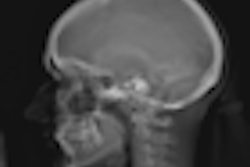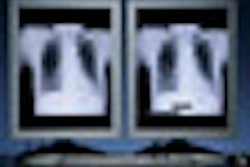Computer-aided detection (CAD) technology may improve the diagnosis of pulmonary embolism for inexperienced readers, according to research from the Medical University of South Carolina (MUSC) in Charleston.
"We've shown [that CAD] can significantly increase the sensitivity in our inexperienced readers," said Kevin Blackmon. "On a per-patient basis, it may improve correct classification of patients in on-call situations."
In today's imaging practice, CT pulmonary angiography has largely replaced conventional angiography for imaging of pulmonary embolism (PE), owing to its better interobserver agreement with peripherally located emboli. This is due, in large part, to recent advances in scanner technology that have increased the quality and quantity of data generated by CT angiography studies, Blackmon said.
"For example, now we can consistently view fifth- and sixth-order peripheral vessels, and this can be done in a single scan," Blackmon said. He presented the MUSC research during a scientific session at the 2008 RSNA meeting in Chicago.
These image quality gains come at a cost, however. The large number of images per CT pulmonary angiography study makes the PE exams cumbersome to evaluate and contributes to the common problem of missed PE, Blackmon said.
"Therefore, an algorithm with constant performance and high sensitivity is desirable as a second reader," he said.
To study the effect of a prototype CAD algorithm (Siemens Healthcare, Malvern, PA), the MUSC researchers retrospectively studied CT pulmonary angiograms of 41 consecutive patients initially identified with PE and 43 consecutive patients initially identified as not having PE.
Two inexperienced radiologists (first-year residents) independently evaluated the studies for PE and then three months later evaluated the same studies with CAD as a second reader. For the purposes of the study, ground truth was established by two experienced radiologists reading in consensus.
The CAD algorithm had been trained on 41 unrelated cases with 156 known PE, Blackmon said. The algorithm initially performs lung segmentation, which separates out the pulmonary-arterial tree from the surrounding parenchyma and chest wall. It then generates PE candidate marks, and through feature extraction and classification it reduces the number of candidates to those most likely to be PE, Blackmon said.
Expert consensus determined that 294 PE were present in the 41 patients with positive PE findings, including 20 central, two lobar, 264 segmental, and eight subsegmental emboli.
The two first-year residents had a 23.13% average sensitivity on their initial interpretation; when using CAD as a second reader, average sensitivity climbed to 45.24% (p < 0.001). On a per-patient basis, sensitivity increased from 27.5/41 (66%) true-positive cases without CAD to 32/41 (78%) true-positive cases with CAD (p < 0.001).
On its own, CAD yielded an overall sensitivity for PE of 82.65%, including 90.15% for segmental emboli, 50% for lobar emboli, 37.5% for subsegmental emboli, and 5% for central emboli.
CAD did, however, yield a low specificity of 32.3%. The readers had an initial specificity of 84%, which dipped to 72% with the use of CAD. False-positive findings increased from 0.52 to 0.81 per case.
"Most of the false positives were clearly located outside of the pulmonary-arterial tree," Blackmon said. "They were commonly located in the pulmonary venous system or located on lymphatic tissue."
The number of false-negative patients was reduced from 15 to 10, thanks to the use of CAD. False-positive cases also increased, however, from 2/41 without CAD to 3.35/41 with CAD.
In future directions, the researchers expect that new algorithms will provide increased sensitivity and fewer false positives. In addition, future studies should evaluate the impact of CAD on interpretation time, Blackmon said. Development of a large, centralized database for pulmonary CT angiography studies would also aid in providing standardized comparison of algorithms, he said.
By Erik L. Ridley
AuntMinnie.com staff writer
February 12, 2009
Related Reading
At CT, not all PE are bad PE, February 4, 2009
Lung CAD shows promise as concurrent reader, January 30, 2009
Lung CAD holds up well in low-dose MDCT studies, November 25, 2008
Researchers cut false positives in lung CAD, November 10, 2008
CAD detects more lung nodules but not necessarily more cancer, September 24, 2008
Copyright © 2009 AuntMinnie.com



















